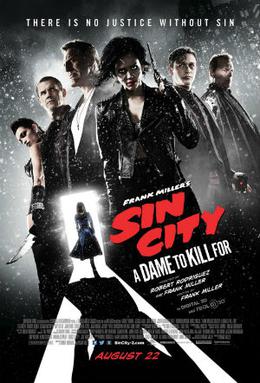
Released: August 22nd, 2014
Rated: R
Studio: The Weinstein Company
Starring: Mickey Rourke, Jessica Alba, Josh Brolin,
Joseph Gordon-Levitt, Rosario Dawson, Bruce Willis, Eva Green, Powers Boothe
Directed by: Frank Miller, Robert Rodriguez
Written by: Frank Miller
Personal Bias Alert:
didn’t like Sin City, gets
distracted when the background exists in a different universe than the actors
5 of 10
Like
the original, Sin City: A Dame to Kill For is less a feature than
a series of shorts. It’s only tied
together in the sense that it takes place in the same town at roughly the same
time, allowing the characters to move in and out of storylines. Also like its predecessor, it’s packed with
stars, guns, leather, unique coloring, terrible dialogue, and poor plots.
This
is a guess, but I think Mickey Rourke had the most screen time, making him the
de facto star. His character, Marv, fits
in so well with the city that he’s almost bound to pop up in every story. He’s big, tough, and always looking for a
fight, which isn’t a difficult search in Basin City (Sin City? What is this town’s name?). He starts one in the opening story Just Another Saturday Night and gets
recruited in A Dame to Kill For and Nancy’s Last Dance. In between, he sucks booze and cigarettes,
lusts after Nancy (Jessica Alba), and laments in clunky noir-style narration
his meaningless life. I think he just
needs to put down the booze and take his pills on time, but this isn’t that kind
of world. As a summation of the city, and
by extension the movie, he’s a natural fit.
He even has a good leather coat.
Perhaps
the only thing Marv’s missing is some good curves, because to go without
mentioning the hyper sexual nature of this film would be a disservice. It’s incredibly preoccupied with the female
body, whether entirely naked or bound in leather. Eva Green’s Ava, the titular dame to kill
for, stars in the largest section of the film, often naked, using her extreme
powers of seduction to get what she wants.
The catch is, she is neither the main character nor the good guy in the
story (both go to Josh Brolin’s Dwight).
Her powers are portrayed as evil, driving men to do the things they are
otherwise able to resist. It’s a sexist
slant that runs through the entire film, as much of the action seems to spawn
from the strip club Nancy works at. Tsk-tsk. We
women and our sexuality are always causing problems.
I know you’re shaking
your head at me for pointing out Sin City’s
sexism, because hey, it’s a selling point.
It’s on par with criticizing it for its cinematography, which is
arguably the most distinctive look in modern cinema. When you see a still from this series, it’s
instantly recognizable. You will never
mistake it for something else. While I’m
not a massive fan of the style, it is interesting if only for its novelty, so
when the story started to drag I remained moderately entertained by its
looks. The hyper sexuality is a natural
extension of this desire to visually entertain, and it’s ultimately successful. Green does look good, as do all the ladies in
the film, so even though it’s appealing to a base desire, I have to give the
film credit for delivering what it promises.
As I mentioned, the
stories do drag at times, with certain ones working better than others. A Dame
to Kill For is by far the most complete story, even if everything in it is
very one-note. Nancy’s Last Dance manages to give fans of the first movie a
gratifying ending, and Just Another
Saturday Night is over so quickly that it’s hard to have a strong opinion. By far the worst is The Long Bad Night, featuring Gordon-Levitt as a talented gambler
taking on Senator Roark. The plot outcome
is so preordained that the story seems pointless, and it adds absolutely
nothing to the tone or overarching themes of the story. Why it exists is a mystery to me.
If I thought this film
was trying to be anything other than pulpy noir, then I would give it a much
lower rating. For what it is, it works
adequately well, and there’s no way you can accuse it of false advertising.
Other
Notes:
Ø No
joke, an anti-smoking ad played in front of my screening.
Ø Throughout
most of Eva Green’s scenes, I imagined her turning to the camera, pointing to
her face, and saying “eyes up here.”
Ø I
feel like a lot of these character’s problems would be solved if they just shot
people in the head faster.

No comments:
Post a Comment